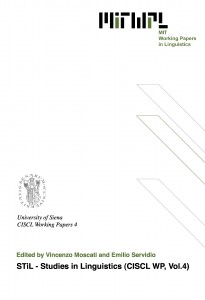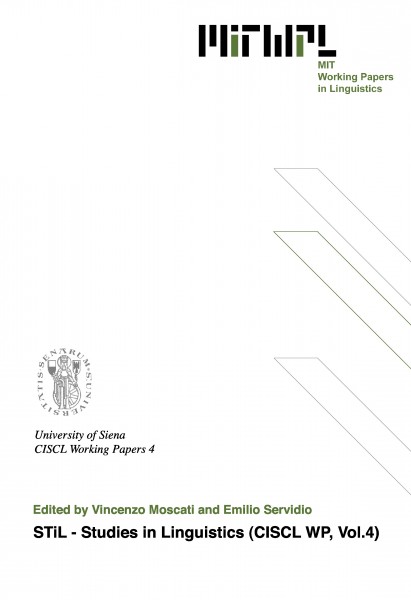University of Siena CISCL Working Papers #4
STiL - Studies in Linguistics (CISCL WP, Vol.4)
Vincenzo Moscati and Emilio Servidio, 2011
ADRIANA BELLETTI & CRISTIANO CHESI
CISCL - University of Siena
Relative clauses from the input: considerations on a corpus-based analysis of Italian
A well-known classical finding from both acquisition and processing is that Object(- headed) Relative Clauses (ORs) are harder than Subject(-headed) Relative Clauses (SRs) for children to acquire, and slower for adults to process (Adams 1990, Adani et al. 2010, Brown 1972, de Villiers et al. 1994, De Vincenzi 1991, Gordon et al. 2004, Tavakolian 1981, Warren & Gibson 2002, among many others). In this work, we aim at investigating which typologies of SRs and ORs are present in corpora of standard Italian and whether their frequency is somehow predictable given some recent experimental findings (Belletti 2009), and the syntactic account that has been proposed in terms of a featural approach to locality (Friedmann et al. 2009).
CARLA CONTEMORI
University of Siena
The comprehension and production of clitics in Italian adults with Down Syndrome: a pilot study
This study reports on findings from an experimental investigation into the knowledge of Binding and the production of object clitic pronouns in a group of Italian adolescents with Down syndrome (DS), compared to a group of typically developing (TD) children aged 3:4- 5:3, matched to the participants with DS on receptive grammar abilities. Previous studies on English adults with DS found a specific difficulty in comprehending reflexives, but not pronouns (Perovic 2006, Ring & Clahsen 2005). With a comprehension study testing the interpretation of reflexive clitics and object clitic pronouns, we observe that both Italian participants with DS and TD children, comprehend the two types of clitics equally well. Moreover, no dissociation is found between reflexive and object clitics in any of the conditions in analysis in the two groups. This results support the hypothesis that reflexive clitics, which are comprehended by Italian adults with DS, are different in nature than reflexive full pronouns, which are impaired in the English population (Kayne 2000, among others). With a task testing the production of pronominal clitics, we observe that object clitic pronouns are particularly challenging for 3 of the 4 subjects with DS. Overall, the group performance of participants with DS is marginally lower than that of the TD controls. We interpret the difficult that (some) of the DS and TD participants experience with the production of object clitics as the result of the their syntactic complexity, as suggested by Hamman & Belletti (2006).
CARLA CONTEMORI & ADRIANA BELLETTI
Universita di Siena - CISCL
Disentangling the mastery of object relatives in children and adults. Evidence from Italian
We investigate the production of subject (SR) and object (OR) relative clauses in Italian typically developing children and adults. We confirm the well known asymmetry between SR and OR for children, with the former more accurately produced than the latter. Moreover, we attest the production of resumptives and relatives with passive to avoid OR with gap. For adults we observe a clear preference for relative clauses with passive as a strategy to avoid ORs. With a picture selection task, we also test the comprehension of OR with gap, ORs with resumptive clitic pronouns and relative clauses with (different types) of passive. We show that the comprehension of relatives with passive is significantly better than that of ORs (with either gap or resumptive clitics) in children aged 6:5-8:10. Furthermore, while comprehension of relatives with passive increases with age, no age effect is detected in the comprehension of ORs with gap or resumptive clitics. We explain the persistent difficulty that children experience with ORs both in production and comprehension as a result of intervention effects, as proposed by Friedmann et al (2009). Furthermore, we adopt Belletti (2009)ís approach to passive derivation to account for the increasing use and more accurate comprehension of relatives with passive over ORs in children.
LENA DAL POZZO and SIMONE GUESSER
CISCL Universit di Siena
A comparative view on answering strategies and new information subjects in Brazilian Portuguese and Finnish
The paper presents a comparative study on subject focalization in Brazilian Portuguese (BP) and Finnish, and in particular on the structures displayed by these languages to focalize subjects in context of new information focus (SNI). The interest of studying subject focalization in BP and in Finnish comes from their peculiar status as partial null subject languages (PNSL), even if at different degrees (cf. Kato (2000); Holmberg 2009). Data have been collected through the experimental design used by Belletti & Leonini (2004) and Belletti, Bennati & Sorace (2007) on answering strategies (cf. Belletti 2006, 2008) which has been administrated to adult native speakers of BP and Finnish. It will be shown that interestingly, both in BP and in Finnish the VS order is not adopted in the relevant SNI focus contexts. When occurring, the VS order is restricted to syntactic-pragmatic conditions which are not observed in the parallel structure in languages like Italian. Hence, the observations on the BP and Finnish data are relevant not only for a comparative analysis of focalization strategies in two PNSL but also because they provide further evidence to the cartographic approach that we are assuming (cf. Cinque (2002), Rizzi (2004), Belletti (2004)).
MARIA GARRAFFA*, ALBERTO DI DOMENICO∞, ROSALIA DI MATTEO∞
*Fondazione Marica De Vincenzi O.N.L.U.S., ∞ Universita degli studi ìG. díAnnunzioî Chieti e Pescara
The syntactic domain of number agreement: attraction effects and pronominal classes
Assuming that agreement processes are the expression of morphosyntactic relations inside a dedicated projection (an Agr phrase), we examine the feature geometry involved in the construction of subject verb agreement relation. A production experiment was carried out in Italian using the attraction paradigm to investigate the various properties of Subject-Verb agreement when different elements occur in an intervening position between the subject and the verb. Attraction is manifested in Italian, and this occurs more frequently with prepositional phrases as intervener than with object clitics. Furthermore, the agreement configuration in the clitic condition in our experiment had a more complex structure, evidenced by the presence of many errors with all plural forms. The agreement domain of the clitic is sensitive to the nature of the pronoun and this can be seen by comparing different Romance languages. Pronouns have different agreement relations at the marking stage according to whether they are weak pronouns or clitics. The results of the study point to a more finely-tuned model of agreement in which the processing of agreement relations is subject to cross-linguistic variation, given the different types of pronoun found in natural languages.
SIMONA MATTEINI
University of Siena
Exploring the L2 syntax/morphology interface in the DP domain: a study on the L2 acquisition of German nominal inflectional morphology by Italian adult learners
This work is mainly concerned with the acquisition of some aspects of the morphosyntax of German possessive constructions by a group of 18 Italian adult L2 learners with different levels of proficiency (Beginners, Intermediate, Advanced learners). In the present study, I address the issue of morphological variability more in details with the attempt to define a fine-graned scenario of L2 strategies adopted by Italian learners when facing the process of morphological insertion. Specifically, the morphosyntactic domains investigated are possessive constructions of the ñs Genitive type. Overall, findings indicate a substantial dissociation between syntax and morphology (i.e. Parodi et al 2004 for L2 acquisition of German nominals by Romance learners). As for syntax, L1 transfer seems to operate in a ëselectiveí way (i.e. discrepancy between early production of L2 AP- NP order vs gradual use of ñs Genitive constructions). As for morphology, different strategies emerged depending on the item involved in the inflectional process (-s Genitives vs APs) as well as on the syntactic configuration in which it is licensed (strong vs weak inflectional contexts). More generally, it emerges an interesting L2 tendency to simplify the morphological architecture of the German AP inflectional paradigm through the substitution of ëdefaultí simpler forms.
LUIGI RIZZI
University of Siena
On the elements of syntactic variation
In the first part of this paper, I would like to go back to the origins of the notion of parameters, briefly present the first steps of parametric theory some 30 years ago, and discuss an important conceptual change that took place very early on in the development of parametric syntax: the identification of the locus of parameters not in the structure of principles, but in the functional lexicon. I will then try to spell out a conception of the format of parameters as elementary instructions for syntactic actions; I will argue that this view is fully consistent with basic tenets of minimalist models, and in fact crucially capitalizes on the restrictive character of minimalist syntax. In the second part, I would like to turn to language acquisition and syntactic variation: how early is abstract grammatical knowledge of cross-linguistically variable properties acquired by the child? I will focus on the acquisition of a fundamental word order property, the VO or OV order, and discuss experiment evidence bearing on this issue. The available experimental evidence supports the view that the child possesses abstract knowledge of word order properties from very early on; this is more naturally compatible with the assumption that a dedicated language faculty, in the form of a parametrized system, constrains linguistic variation.

